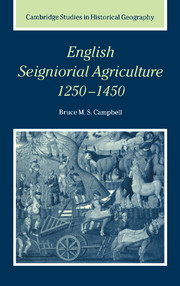Book contents
- Frontmatter
- Contents
- List of figures
- List of tables
- Preface and acknowledgements
- Abbreviations
- Weights, measures, values, and boundaries
- 1 Introduction: agriculture and the late-medieval English economy
- 2 Sources, databases, and typologies
- 3 The scale and composition of the seigniorial sector
- 4 Seigniorial pastoral production
- 5 Seigniorial arable production
- 6 Crop specialisation and cropping systems
- 7 Arable productivity
- 8 Grain output and population: a conundrum
- 9 Adapting to change: English seigniorial agriculture 1250–1450
- Appendix 1 Demesne-level classification of husbandry types
- Appendix 2 Demesnes represented in the Norfolk accounts database
- Appendix 3 Demesnes represented in the FTC accounts databases
- Consolidated bibliography
- Index
- Cambridge Studies in Historical Geography
1 - Introduction: agriculture and the late-medieval English economy
Published online by Cambridge University Press: 20 October 2009
- Frontmatter
- Contents
- List of figures
- List of tables
- Preface and acknowledgements
- Abbreviations
- Weights, measures, values, and boundaries
- 1 Introduction: agriculture and the late-medieval English economy
- 2 Sources, databases, and typologies
- 3 The scale and composition of the seigniorial sector
- 4 Seigniorial pastoral production
- 5 Seigniorial arable production
- 6 Crop specialisation and cropping systems
- 7 Arable productivity
- 8 Grain output and population: a conundrum
- 9 Adapting to change: English seigniorial agriculture 1250–1450
- Appendix 1 Demesne-level classification of husbandry types
- Appendix 2 Demesnes represented in the Norfolk accounts database
- Appendix 3 Demesnes represented in the FTC accounts databases
- Consolidated bibliography
- Index
- Cambridge Studies in Historical Geography
Summary
The seigniorial and non-seigniorial sectors
Between c. 1250 and c. 1450, for the first time in recorded English history, it becomes possible to reconstruct the development and performance of agriculture in some detail. Several different categories of producer – demesne lords, owners of rectorial glebe, franklins and proto-yeomen, substantial customary tenants, lesser customary tenants, and small freeholders – were involved in shaping the course of agricultural development over this eventful period, but it is the activities of the demesne lords that are the most copiously documented. For demesne farms alone detailed input and output data are available at the level of the individual production unit. It is the analysis of these data that forms the subject of this book. Not only do the insights thereby obtained have implications for agriculture in general but in an overwhelmingly agrarian age any verdict on the agricultural sector – limited and qualified though it may be – has important implications for how the medieval economy is viewed as a whole.
Notwithstanding their many obvious differences, seigniorial and non-seigniorial producers shared much in common. Most conspicuously, they shared a common technology. Indeed, much of the labour-force and know how used in the management of demesnes came from the non-seigniorial sector with the result that the husbandry documented on demesnes was strongly influenced by local practice.
- Type
- Chapter
- Information
- English Seigniorial Agriculture, 1250–1450 , pp. 1 - 25Publisher: Cambridge University PressPrint publication year: 2000
- 2
- Cited by



